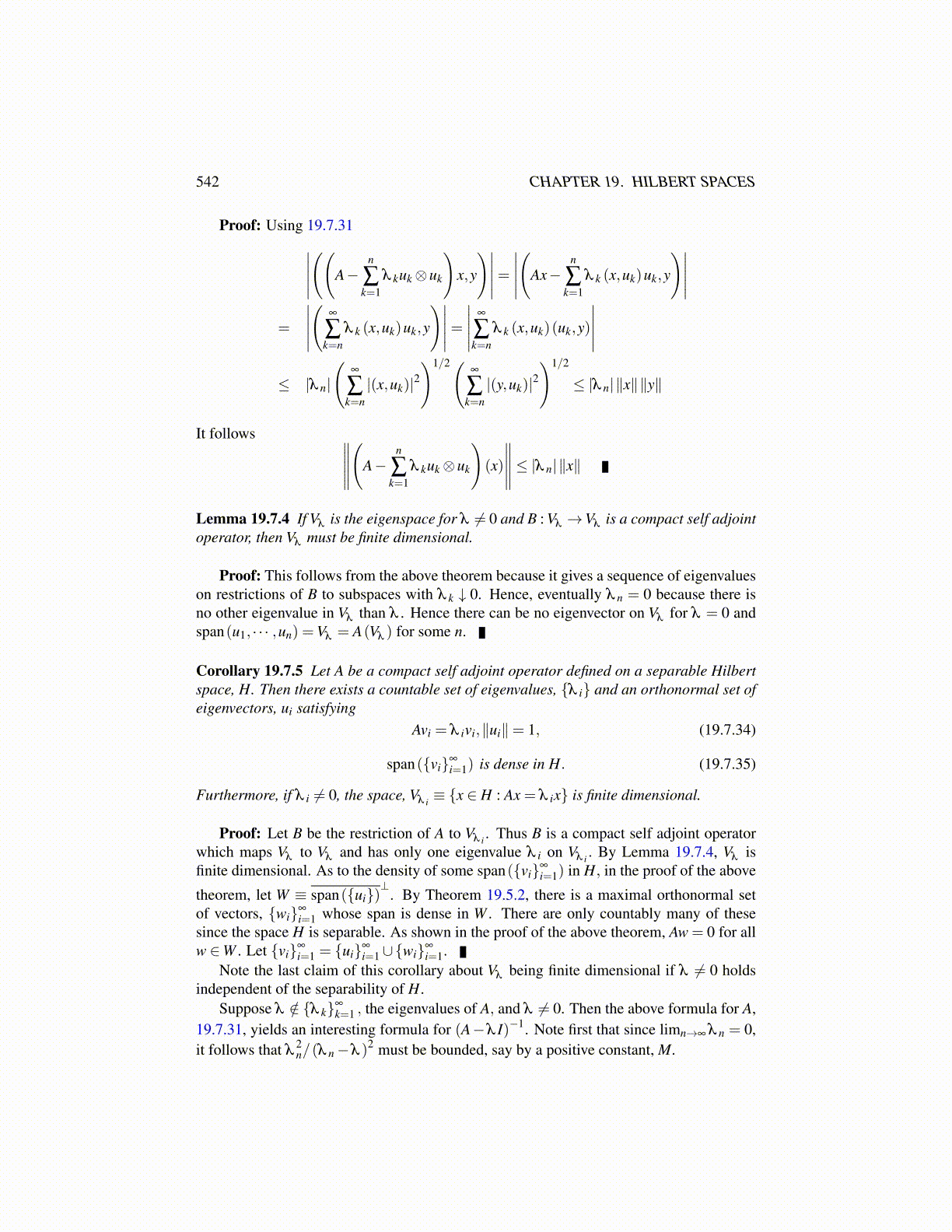
542 CHAPTER 19. HILBERT SPACES
Proof: Using 19.7.31∣∣∣∣∣((
A−n
∑k=1
λ kuk⊗uk
)x,y
)∣∣∣∣∣=∣∣∣∣∣(
Ax−n
∑k=1
λ k (x,uk)uk,y
)∣∣∣∣∣=
∣∣∣∣∣(
∞
∑k=n
λ k (x,uk)uk,y
)∣∣∣∣∣=∣∣∣∣∣ ∞
∑k=n
λ k (x,uk)(uk,y)
∣∣∣∣∣≤ |λ n|
(∞
∑k=n|(x,uk)|2
)1/2(∞
∑k=n|(y,uk)|2
)1/2
≤ |λ n|∥x∥∥y∥
It follows ∥∥∥∥∥(
A−n
∑k=1
λ kuk⊗uk
)(x)
∥∥∥∥∥≤ |λ n|∥x∥
Lemma 19.7.4 If Vλ is the eigenspace for λ ̸= 0 and B : Vλ →Vλ is a compact self adjointoperator, then Vλ must be finite dimensional.
Proof: This follows from the above theorem because it gives a sequence of eigenvalueson restrictions of B to subspaces with λ k ↓ 0. Hence, eventually λ n = 0 because there isno other eigenvalue in Vλ than λ . Hence there can be no eigenvector on Vλ for λ = 0 andspan(u1, · · · ,un) =Vλ = A(Vλ ) for some n.
Corollary 19.7.5 Let A be a compact self adjoint operator defined on a separable Hilbertspace, H. Then there exists a countable set of eigenvalues, {λ i} and an orthonormal set ofeigenvectors, ui satisfying
Avi = λ ivi,∥ui∥= 1, (19.7.34)
span({vi}∞
i=1) is dense in H. (19.7.35)
Furthermore, if λ i ̸= 0, the space, Vλ i ≡ {x ∈ H : Ax = λ ix} is finite dimensional.
Proof: Let B be the restriction of A to Vλ i . Thus B is a compact self adjoint operatorwhich maps Vλ to Vλ and has only one eigenvalue λ i on Vλ i . By Lemma 19.7.4, Vλ isfinite dimensional. As to the density of some span({vi}∞
i=1) in H, in the proof of the above
theorem, let W ≡ span({ui})⊥
. By Theorem 19.5.2, there is a maximal orthonormal setof vectors, {wi}∞
i=1 whose span is dense in W . There are only countably many of thesesince the space H is separable. As shown in the proof of the above theorem, Aw = 0 for allw ∈W . Let {vi}∞
i=1 = {ui}∞
i=1∪{wi}∞
i=1.Note the last claim of this corollary about Vλ being finite dimensional if λ ̸= 0 holds
independent of the separability of H.Suppose λ /∈ {λ k}∞
k=1 , the eigenvalues of A, and λ ̸= 0. Then the above formula for A,19.7.31, yields an interesting formula for (A−λ I)−1. Note first that since limn→∞ λ n = 0,it follows that λ
2n/(λ n−λ )2 must be bounded, say by a positive constant, M.